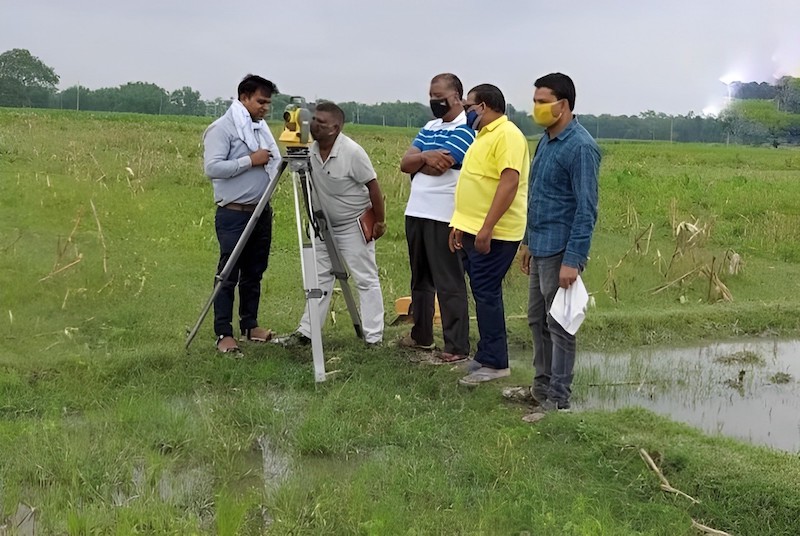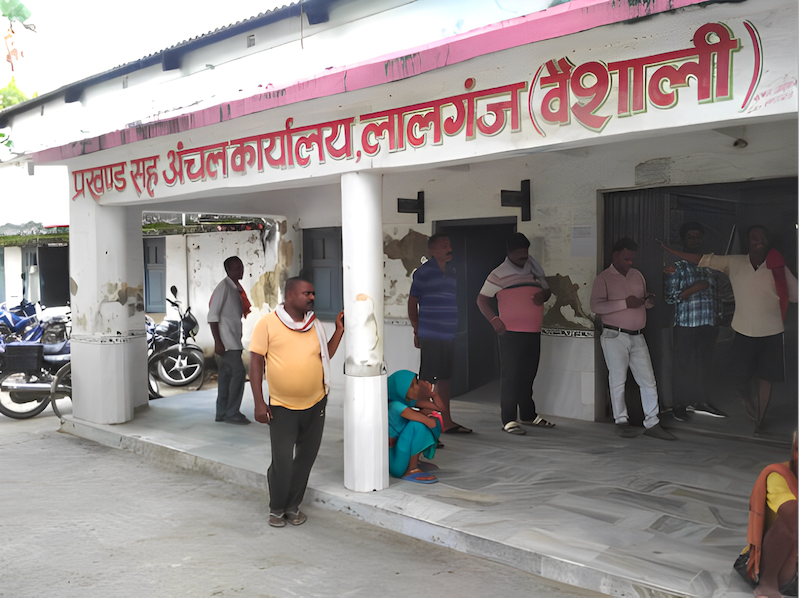 A land survey being carried out in Bihar. (Photo courtesy: ASJ)
A land survey being carried out in Bihar. (Photo courtesy: ASJ)
Hajipur, Bihar: A transition is underway in Bihar. This pertains to the special land survey being conducted in 45,000 villages across the state. The government has appointed 10,000 officials to quicken the pace of the special survey and is expecting to complete it by August 2025.
It is noteworthy that the Department of Revenue and Land Reforms under the Bihar government has already digitized 64 million revenue documents of different hues, and digitization of 160–200 million documents is slated to be completed within a year or so. People would get those documents by paying a certain amount of fees.
The chief objective of the survey is to digitize the data and map of the entire land of the state to bring transparency to land dealing and resolve chronic land disputes as courts in Bihar are laden with ever-piling cases of land litigations.
Vinod Kumar Singh, Vaishali’s additional district magistrate, in a matter-of-fact manner, says, “Our prime efforts are being geared up to prepare kistwar (plotting) and khanapuri to ensure legitimate ownership of lands.”
 Vinod Kumar Singh, ADM, Vaishali. (India Sentinels photo)
Vinod Kumar Singh, ADM, Vaishali. (India Sentinels photo)
What Singh has opined is least debatable. This is more so because in Bihar, 60 per cent of land-related crimes have cropped up due to missing and non-availability of record of right of lands with the real owner of the land. There are a sizable number of cases – being fought in courts of law in Bihar – in which disingenuous elements fraudulently prepared a record of rights related to lands in their names.
Upon being asked about the confusion reigning among people at large regarding approval of filled-up “vanshavali” form (pedigree form), such as “from whom to seek approval on the form?” Singh forbids people to seek approval from the village sarpanch (head of a panchayat). Singh said people themselves could certify, approve and submit it along with the self-declaration “Form 2” or “Prapatra 2”.
“Filling up vanshavali form by inheritors of properties is all the more necessary in case of ancestral properties of grandfather, great-grandfather and great-great-grandfather respectively, irrespective of the kind of ownership acquired by them such as through “khatiyan” or property sale deed, etc,” says Vipin Kumar Yadav, settlement officer (bandobast adhikari) of Vaishali district.
 Vipin Kumar Yadav, bandobast adhikari, Vaishali. (India Sentinels photo)
Vipin Kumar Yadav, bandobast adhikari, Vaishali. (India Sentinels photo)
Yadav goes on to clarify that in ancestral properties, when property is in father’s name and agricultural rent (bhumi lagaan) is being paid by him, then there is no need to prepare vanshavali (pedigree). But if the father as an owner of land desires his property to be distributed among his sons and daughters, in that event vanshavali form (pedigree form) needs to be filled up along with self-declaration Form 2, explains Yadav.
As a matter of fact, khatiyan is a legal government document which encompasses record of rights pertaining to “khata” (account) number, kheasara (plot) number, mouza (specific area), name of raiyat (tenant with right to hold land) and rakaba (area of the land in possession by the tenant, acreage). Precisely speaking, khatiyani land refers to ancestral immovable property.
 The Lalganj Circle Office in Vaishali, one of the many in Bihar, where relevant forms can be filled to claim land ownership. (India Sentinels photo)
The Lalganj Circle Office in Vaishali, one of the many in Bihar, where relevant forms can be filled to claim land ownership. (India Sentinels photo)
Anyhow, the efforts to digitise lands and map of the lands in state through the special land survey are praiseworthy. This is more so because measures taken to minimise the ever-increasing land disputes in the state would pave the way for farmers to work with renewed energy (because, currently, their time and energies are being wasted on unwarranted litigations) for enhancing agricultural productivity in their lands.
Last but not least, all stakeholders related to agricultural lands would do well to remember that in India, agriculture contributes 18 per cent growth to the state’s GDP.







